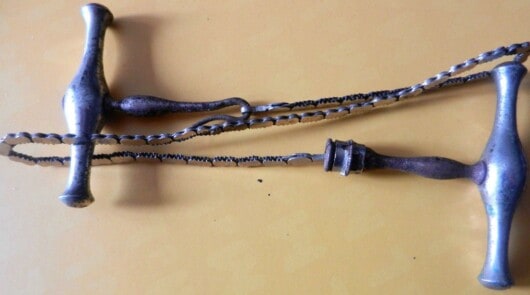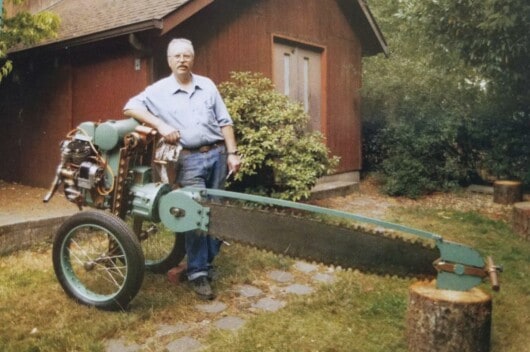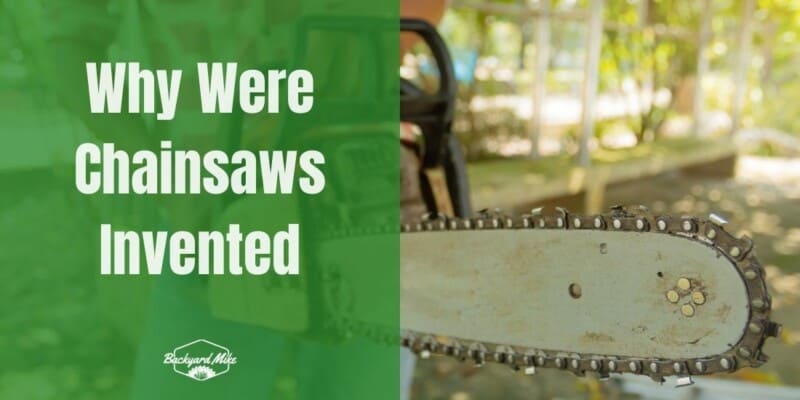Have it ever happened that you’re using your chainsaw and suddenly, you wonder, “Why were chainsaws invented?” Do you also find the history of chainsaws fascinating?
The truth about chainsaws is equally shocking as it is haunting. Chainsaws were actually invented to be used during childbirth. Continue reading to know more about it.
Why were chainsaws invented?
At some point, you would have probably wondered why were chainsaws invented. The horrifying answer to that is – for childbirth. Chainsaws were invented and used for helping women deliver their babies.
Chainsaws were used if a woman was delivering a baby in a breech position or if the baby was “stuck”. A hand-cranked chainsaw with cutting teeth was used for cutting through her cartilage/ligaments to help get the baby out. Just imagine, before caesarian sections became a common thing, all the babies used to cut out through the birth canal. Such devices were necessary during some instances.
Before you let your imagination run wild, the chainsaws invented to help during childbirth were different from modern chainsaws. It is normal to have the image of modern chainsaws in your mind when you read the answer. Just think about it, an obstetrician coming into the delivery room revving up a 90cc chainsaw. If that was the case, half of the women would have passed out at the sight and sound of chainsaws.
Meanwhile, the other half would have been so horrified that they’d have given birth even if the baby was stuck. However, as you can clearly see from the image mentioned above, it isn’t comparable to chainsaws used for cutting branches. Try using it for cutting firewood, and if you’re lucky, you might end the day breaking a thin branch.
The earlier chainsaws were more like large knives with chains attached to them. It is fair to think doctors back then wouldn’t have needed to wear chaps and helmets to operate chainsaws.
The role of chainsaws in the symphysiotomy treatment
The chainsaws used in the past bear little resemblance to the modern chainsaws used today. The chainsaws of the past were invented solely for childbirth. The procedure was called “symphysiotomy” and it has since been termed an outdated surgical procedure. During this procedure, the cartilage of the pubic symphysis would be divided to widen the pelvis to allow childbirth if there was a mechanical problem.
A large portion of people who went through this procedure term it was a butchering. Many women were left brutalized by the practice, leaving them unable to properly walk after childbirth. Some even had lifelong consequences after going through this. Some of the possible scenarios when chainsaws had to be used during childbirth –
- Breech birth – This happened when the baby was coming out with feet first
- The baby’s head was failing to transition through the birth canal
- The baby had their shoulders stuck, which is a dangerous position for both the baby and the mom
To make the situation worse, the procedure was originally performed without anesthesia. In some situations, there was even breaking of bones involved. Once anesthesia was introduced, the procedure was used even more frequently. However, the caesarian section was soon introduced and it started to be used in place of a chainsaw in childbirth. Instead of widening the pelvis, a small, less intrusive abdominal incision is made for retrieving the baby.
When did the practice of using chainsaws for childbirth stop?
The usage of medical chainsaws during childbirth continued into the West into the late 1800s, although made improvements were made. It is believed that chainsaws are still used in a few parts of the world today. In situations in which a cesarean isn’t possible, the Gigli saw is used instead of the original medical chainsaws.

Both the medical chainsaw and the Gigli saws were used for amputating limbs and removing deceased flesh hand bones. However, the original purpose was to help women who have trouble delivering their babies.
Where were chainsaws invented?
The original chainsaw was invented by two Scottish doctors, John Aitken and James Jeffray back in the 1780s. The duo based their design on the watch chain teeth positioned with a hand crank. Besides childbirth, the chainsaws by the Scottish duo were used for procedures like removing diseased bone, amputating limbs, and cutting flesh.
Who started electrical chainsaws?
In 1926, Andreas Stihl, a German Mechanical Engineer, invented the electric chainsaw. The chainsaw was launched for woodcutting and pruning purposes. At the time, the weight of the chainsaw was around 120 lbs, and needed multiple people to operate the chainsaw.
Who started gas chainsaws?
Dolmar Chainsaw brand started manufacturing gas-powered chainsaws in 1927. The brand also launched its own gas chainsaws in 1929 as gas presented more power than the electric input. It was a cost-effective solution at a time when chainsaws had bulky sizes.
The chainsaws came into wide usage in the 1930s and were even used in World War II. It helped to meet the wood and timber requirements. After the industrial revolution, steel and aluminum components became lighter and it impacted the chainsaw design.
The evolution of chainsaws
As mentioned previously, it was only in the 1920s that the first electric chainsaw was invented. Three companies were pivotal during that era of chainsaws. Stihl in Germany, Westfelt in Sweden, and Wolf in the USA. Stihl is the oldest and the largest producer of electric chainsaws in the world. Stihl is so synonymous with chainsaws that it is the first name that comes to mind when using “electric chainsaw”. Initially, their goal was to make heavy forestry labor easier by using a lighter and more dynamic machine.
Both types of modern chainsaws were initially manufactured in the 1920s. Initially, the chainsaws were so heavy that they had to be operated by 2 people. This was the case due to the result of similarities with traditional chainsaws and other technical considerations. While engine-powered chainsaws were very effective in forestry work, it did take a while for their popularity to gain popularity.
Initially, the chainsaws were very heavy and complicated to use. The first two chainsaw models weigh in excess of 132 lbs. They were susceptible to breakdown with ease. It took two people for operating the chainsaw and by the end of the task, they were incredibly fatigued. Despite being useful products at the time, the chainsaw brands weren’t satisfied with the electric chainsaws. They were determined to develop more powerful and lighter chainsaws that could be operated by an individual effectively.

In 1950, the first 1-man chainsaw was developed, although it was still a bit on the heavier side. By 1959, most chainsaws had a weight of around 26 lbs. For better context, the chainsaws today weigh between 11 lbs – 15 lbs.
By the end of the 50s, there was a lack of eager lumberjacks who were willing to take on forestry work. This resulted in a drive to get more youths involved in working with chainsaws. To make things interesting, chainsaw brands started to get creative and add new features. Some of the features added in the last few decades were chain brake, automatic chain brake, anti-vibration system, and more.
The manufacturers felt that not only would it lead to an increase in productivity, but also make profits. Here is a brief timeline of the evolution of chainsaws through the years.
- In 1926, Andreas Stihl, a German Mechanical Engineer invented the first electric chainsaw
- In 1927, Dolmar Chainsaw invented the first petrol/fuel-powered chainsaw
- 1950 saw the rise of the first individual operated chainsaw
- In 1964, the anti-vibration system came into existence
- In 1972, chain brake was introduced into chainsaws
- In 1982, the automatic chain brake was used for the first time
- In 1989, a catalyzer was used in chainsaws
- In 1991, an electric chainsaw featured the use and implementation of automatic start ability
Risks of working with modern chainsaws
It should come as no surprise that working with modern chainsaws is extremely dangerous. In fact, statistics show that each year there are approx. 36,000 chainsaw accidents in the USA alone. The injuries normally occur on the exposed parts of your body when you’re operating a chainsaw. Some of the regions at risk are the neck, chest, left arm, and left leg. The most common cause of these injuries is the chainsaw kickback.
It occurs when the nose and chains of the chainsaw meet wood at a critical angle. It also happens when the saw comes in contact with an unexpected object and rises suddenly. There is also the risk of developing the “white finger syndrome”. This is caused by the constant vibration that is produced when using the chainsaw for longer durations.
Conclusion
Hopefully, this guide would have given you more than enough information about why were chainsaws invented, when were chainsaws invented, and where were chainsaws invented. As unbelievable as it may sound, chainsaws were initially used for childbirth. This was as brutal as it sounds and had long-term consequences for the women involved. Some of them even had broken bones while others were left unable to walk properly.
As for the modern chainsaws used for cutting and pruning, the industry has German Mechanic Engineer Andreas Stihl to thank. Stihl came out with the very first electric-powered chainsaw back in 1926. Meanwhile, gas-powered chainsaws were invented the following year.


